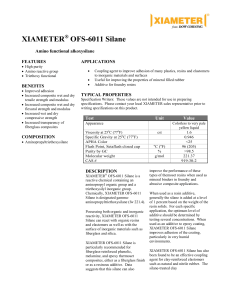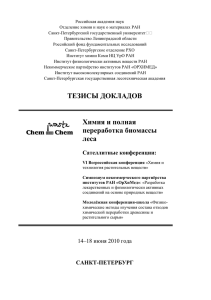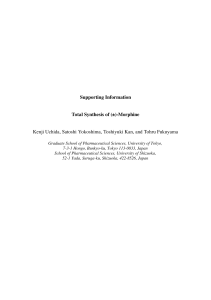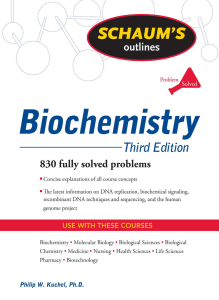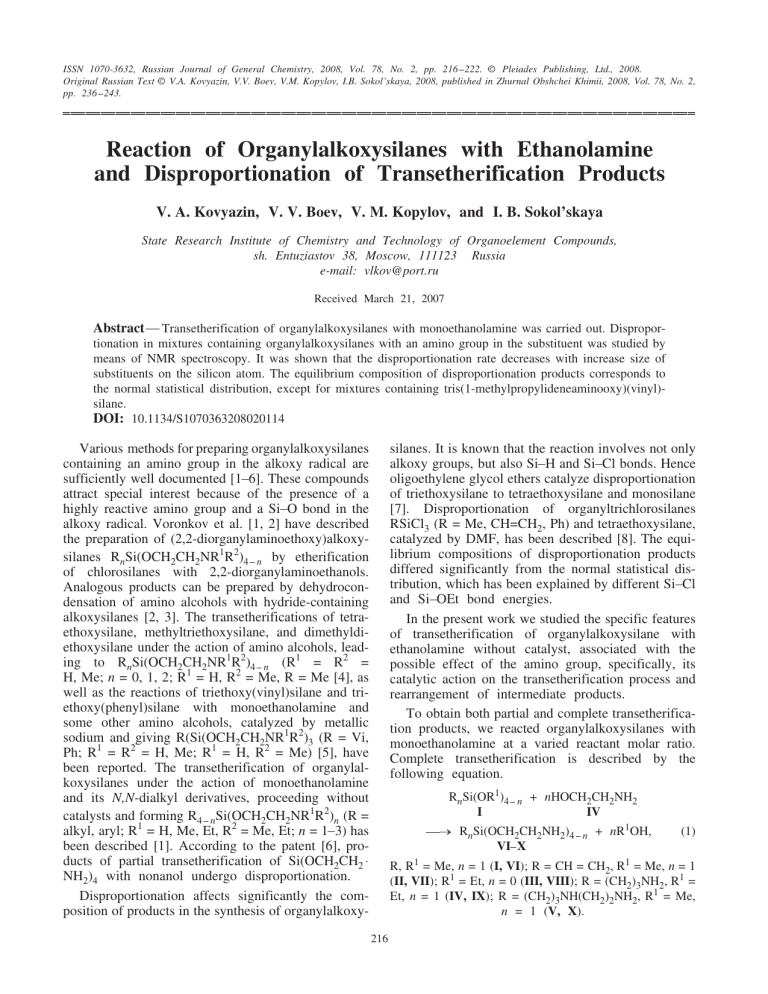
ISSN 1070-3632, Russian Journal of General Chemistry, 2008, Vol. 78, No. 2, pp. 216 !222. + Pleiades Publishing, Ltd., 2008.
Original Russian Text + V.A. Kovyazin, V.V. Boev, V.M. Kopylov, I.B. Sokol’skaya, 2008, published in Zhurnal Obshchei Khimii, 2008, Vol. 78, No. 2,
pp. 236 !243.
ÍÍÍÍÍÍÍÍÍÍÍÍÍÍÍÍÍÍÍÍÍÍÍÍÍÍÍÍÍÍÍÍÍÍÍÍÍÍÍÍÍÍÍÍÍÍÍÍÍÍÍÍÍÍÍÍÍÍÍÍÍÍÍÍÍÍÍÍÍÍÍÍÍÍÍÍÍÍÍÍÍÍÍÍ
Reaction of Organylalkoxysilanes with Ethanolamine
and Disproportionation of Transetherification Products
V. A. Kovyazin, V. V. Boev, V. M. Kopylov, and I. B. Sokol’skaya
State Research Institute of Chemistry and Technology of Organoelement Compounds,
sh. Entuziastov 38, Moscow, 111123 Russia
e-mail: vlkov@port.ru
Received March 21, 2007
-
Abstract Transetherification of organylalkoxysilanes with monoethanolamine was carried out. Disproportionation in mixtures containing organylalkoxysilanes with an amino group in the substituent was studied by
means of NMR spectroscopy. It was shown that the disproportionation rate decreases with increase size of
substituents on the silicon atom. The equilibrium composition of disproportionation products corresponds to
the normal statistical distribution, except for mixtures containing tris(1-methylpropylideneaminooxy)(vinyl)silane.
DOI: 10.1134/S1070363208020114
silanes. It is known that the reaction involves not only
alkoxy groups, but also Si3H and Si3Cl bonds. Hence
oligoethylene glycol ethers catalyze disproportionation
of triethoxysilane to tetraethoxysilane and monosilane
[7]. Disproportionation of organyltrichlorosilanes
RSiCl3 (R = Me, CH=CH2, Ph) and tetraethoxysilane,
catalyzed by DMF, has been described [8]. The equilibrium compositions of disproportionation products
differed significantly from the normal statistical distribution, which has been explained by different Si3Cl
and Si3OEt bond energies.
In the present work we studied the specific features
of transetherification of organylalkoxysilane with
ethanolamine without catalyst, associated with the
possible effect of the amino group, specifically, its
catalytic action on the transetherification process and
rearrangement of intermediate products.
To obtain both partial and complete transetherification products, we reacted organylalkoxysilanes with
monoethanolamine at a varied reactant molar ratio.
Complete transetherification is described by the
following equation.
Various methods for preparing organylalkoxysilanes
containing an amino group in the alkoxy radical are
sufficiently well documented [136]. These compounds
attract special interest because of the presence of a
highly reactive amino group and a Si3O bond in the
alkoxy radical. Voronkov et al. [1, 2] have described
the preparation of (2,2-diorganylaminoethoxy)alkoxysilanes RnSi(OCH2CH2NR1R2)4 ! n by etherification
of chlorosilanes with 2,2-diorganylaminoethanols.
Analogous products can be prepared by dehydrocondensation of amino alcohols with hydride-containing
alkoxysilanes [2, 3]. The transetherifications of tetraethoxysilane, methyltriethoxysilane, and dimethyldiethoxysilane under the action of amino alcohols, leading to RnSi(OCH2CH2NR1R2)4 ! n (R1 = R2 =
H, Me; n = 0, 1, 2; R1 = H, R2 = Me, R = Me [4], as
well as the reactions of triethoxy(vinyl)silane and triethoxy(phenyl)silane with monoethanolamine and
some other amino alcohols, catalyzed by metallic
sodium and giving R(Si(OCH2CH2NR1R2)3 (R = Vi,
Ph; R1 = R2 = H, Me; R1 = H, R2 = Me) [5], have
been reported. The transetherification of organylalkoxysilanes under the action of monoethanolamine
and its N,N-dialkyl derivatives, proceeding without
catalysts and forming R4 ! nSi(OCH2CH2NR1R2)n (R =
alkyl, aryl; R1 = H, Me, Et, R2 = Me, Et; n = 133) has
been described [1]. According to the patent [6], products of partial transetherification of Si(OCH2CH2 .
NH2)4 with nonanol undergo disproportionation.
Disproportionation affects significantly the composition of products in the synthesis of organylalkoxy-
RnSi(OR1)4 ! n + nHOCH2CH2NH2
I
IV
76 R Si(OCH CH NH ) !
n
2
VI!X
2
2 4 n
+ nR1OH,
(1)
R, R1 = Me, n = 1 (I, VI); R = CH = CH2, R1 = Me, n = 1
(II, VII); R1 = Et, n = 0 (III, VIII); R = (CH2)3NH2, R1 =
Et, n = 1 (IV, IX); R = (CH2)3NH(CH2)2NH2, R1 = Me,
n = 1 (V, X).
216
REACTION OF ORGANYLALKOXYSILANES WITH ETHANOLAMINE
3
Physicochemical characteristics of products VI
VIII are consistent with reported data. Characteristics
of new products IX, X are presented in Experimental.
2.5
2.0
Partial transetherification in the tetraethoxysilane3
ethanolamine system (1 : 1 molar ratio) gave, after
rectification, a number of products with different
degrees of substitution.
1.5
Si(OC2H5)4 + HOCH2CH2NH2
0.5
76 (C H O) ! Si(OCH CH NH )
2 5
4 n
2
XI!XIII
2
2 n
+ nC2H5OH, (2)
(C2H5O)3Si(OCH2CH2NH2)
XI
XI
(3)
Lukevits et al. [3] showed that in the synthesis of
(2-aminoethoxy)(diethoxy)methylsilane by dehydrocondensation of diethoxy(methyl)silane with monoethanolamine, the reaction mixture, together with the
target product, contained bis(2-aminoethoxy)(ethoxy)methylsilane. The formation of the latter compound
was probably favored by a side disproportionation
reaction. The same authors described the synthesis of
compound XI from triethoxysilane and monoethanolamine, but mentioned no by-products. To confirm the
possibility of disproportionation in such reaction
systems, we undertook a 29Si NMR study of a mixture
of tetraethoxysilane and tetrakis(2-aminoethoxy)silane
(VIII).
The choice of tetramethoxysilane as the second
reaction component was motivated by the fact that the
RUSSIAN JOURNAL OF GENERAL CHEMISTRY
4
2
0.0
0
5
1
5000
10 000 15000 20000 25000
Time, min
Fig. 1. Concentration3time curves for (1) tetramethoxysilane and compounds (2) XV, (3) XVI, (4) XIV, and
(5) VIII in the course of the disproportionation reaction
between tetramethoxysilane and compound VIII (20oC).
signal of its silicon atom is observed at dSi 379.1 ppm,
while the signals of tetra(2-R-ethoxy)silanes (R = H,
NH2) fall in the range dSi 382.2 to 382.8 ppm. Such
difference in the chemical shifts facilitates identification of disproportionation products. The reaction
between tetramethoxysilane and tetrakis(2-aminoethoxy)silane (VIII) can be presented by the following scheme.
Si(OCH2CH2NH2)4 + Si(OCH3)4
VIII
TMOS
$ Si(OCH )
"
3 4
TMOS
+ (CH3O)3Si(OCH2CH2NH2)
XIV
$ III + (C H O) Si(OCH CH NH )
2 5 3
2
2
2
"
+ (C2H5O)2Si(OCH2CH2NH2)2.
XII
3
1.0
n = 1 (XI), 2 (XII), 3 (XIII).
The ratio of integral intensities of signals in the 1H
NMR spectrum of the transetherification product corresponds to compound XI, whereas the 29Si NMR
spectrum contains three signals at dSi 382.23, 382.27,
and 382.31 ppm, which implies formation of three
products. Since in the course of vacuum rectification
we collected a fraction boiling at 90oC (5 mm Hg),
bearing in mind the published boiling point of product
XI [77378oC (2 mm Hg) [3]), then a suggestion was
made that this product undergoes disproportionation
catalyzed by its own amino group to give a mixture
of compounds with different degrees of substitution
of the ethoxy groups by 2-aminoethoxy groups. The
three signals in the 29Si NMR spectrum probably
relate to tetraethoxysilane and compounds XI and XII.
217
Vol. 78
+ (CH3O)2Si(OCH2CH2NH2)2
XV
+ (CH3O)Si(OCH2CH2NH2)3 + Si(OCH2CH2NH2)4. (4)
XVI
VIII
Figure 1 presents the concentration3time curves
for the starting compounds and disproportionation
products, measured by 29Si NMR.
As seen from Fig. 1, disproportionation really takes
place in the tetramethoxysilane3compound VIII reaction system at room temperature. At 60oC, this reaction reaches equilibrium in 12 h (Fig. 2), and the
product ratio is close the normal statistical distribution:
tetramethoxysilane : XIV : XV : XVI : VIII = 1 : 3.8 :
ppm:
6.9 : 4.9 : 1.3 (calculated 1 : 4 : 6 : 4 : 1); dSi,
379.36 (tetramethoxysilane), 380.14 (XIV), 380.94
(XV), 381.73 (XVI, and 382.54 (VIII). The signals
of the disproportionation products were assigned
under the assumption that the chemical shift varies
linearly with the degree of substitution of alkoxy
groups (cf. [9]), except for tris(1-methylpropylideneNo. 2
2008
218
KOVYAZIN et al.
koxyvinylsilanes, because in such reaction systems
only of three reversible reactions are possible. Each of
them is characterized by the equilibrium constant Ki:
ViSi(OCH2CH2NH2)3 + ViSi(OR)3
VII
XVIIa!XVIIc
76 ViSi(OCH CH NH )
47
K1
2
2
2 3
+ ViSi(OCH2CH2NH2)(OR)2,
XVIIIa!XVIIIc
XIXa!XIXc
(5)
VII + XIXa!XIXc
76 ViSi(OCH CH NH ) (OR),
47
K2
2
377.0 378.0 379.0 380.0 381.0 382.0 383.0 384.0 385.0 386.0
d, ppm
2
2 2
XVIIIa!XVIIIc
ViSi(OCH2CH2NH2)2(OR) + ViSi(OR)3
XVIIIa!XVIIIc
XVIIa!XVIIc
76 2ViSi(OCH CH NH ) (OR) ,
47
K3
2
2
2 2
(6)
2
R = Me (a), Et (b), N=CMeEt (c).
It was found that for the above-mentioned vinylsilanes the composition of the disproportionation
products at 60oC reaches the equilibrium state within
4 h. The mean equilibrium constants characteristic of
the disproportionation of tris(2-aminoethoxy)(vinyl)silane with silanes of the general formula ViSi(OR)3
(R = Me, Et, N = CMeEt) are presented below.
376.0 378.0
380.0
382.0
384.0
386.0
d, ppm
Fig. 2. 29Si NMR spectra of the tetramethoxysilane3VIII
(1 : 1 molar ratio) reaction mixture (a) before reaction
and (b) after 12 h at 60oC.
aminooxy)(vinyl)silane. To assess the effect of substituent on the silicon atom on the reaction rate and
compare the equilibrium product distributions with
statistical, we studied disproportionation between
various organylalkoxysilanes by 29Si NMR spectroscopy. The objects for study were the following
systems:
1). ViSi(OCH2CH2NH2)3 : ViSi(OR)3,
(R = Me, Et, N=CMeEt)
2). ViSi(ON=CMeEt)3 : AlkNSi(OR)3
[AlkN = H2N(CH2)3-, R = Et, Me; AlkN =
H2N(CH2)2NH(CH2)3-, R = Me]
3). RSi(OCH2CH2NH2)3 : Si(OMe)4
[R = Vi, Me, NH2(CH2)3-, NH2(CH2)2NH(CH2)3-]
The simplest case is the disproportionation between
tris(2-aminoethoxy)(vinyl)silane (VII) and other al-
Kn ViSi(OMe)3 ViSi(OEt)3 ViSi(ON=CMeEt)3
+
+
+
K1 9.11 2.49
K2 2.56 0.49
K3 3.43 0.38
+
+
+
7.84 0.92
2.74 0.22
2.86 0.10
+
+
+
127.24 29.79
12.12 2.59
11.56 2.14
Normal
statistical
distribution
9
3
3
The product distribution in the disproportionation
of ViSi(OMe)3 (XVIIa) and ViSi(OEt)3 (XVIIb) with
ViSi(OCH2CH2NH2) is close to statistical (Table 1).
In the reaction of ViSi(OCH2CH2NH2)3 with ViSi .
(ON=CMeEt) (XVIIc), significant deviation from the
statistical distribution to silanes with mixed alkoxy
groups is observed (Fig. 3, Table 1), and the equilibrium constant Ki is an order of magnitude higher than
in the first two cases.
Comparison of the reactivities of vinylalkoxysilanes toward ViSi(OCH2CH2NH2)3 showed that the
fastest reacting is ViSi(ON=CMeEt), and the difference in the consumption rates of ViSi(OMe)3 and
ViSi(OEt)3 is evidently determined by the size of the
alkoxy groups (the initial consumption rate ratio
wXVIIc : wXVIIa :wXVIIb is ~85 : 18 : 1, and the ViSi .
(OCH2CH2NH2)3 consumption rate ratio is 3.1 : 1.3 : 1,
respectively).
Since ViSi(ON=CMeEt) exhibited quite a high reactivity in the disproportionation reaction, we checked
RUSSIAN JOURNAL OF GENERAL CHEMISTRY
Vol. 78
No. 2
2008
REACTION OF ORGANYLALKOXYSILANES WITH ETHANOLAMINE
219
Table 1. Equilibrium product molar fractions (%) for the disproportionation ViSi(OCH2CH2NH2)3 with ViSi(OR)3 at
varied molar ratios of the starting components
ÄÄÄÄÄÄÄÄÂÄÄÄÄÄÄÄÄÄÄÄÄÄÄÄÄÂÄÄÄÄÄÄÄÄÄÄÄÄÄÄÄÄÄÄÄÂÄÄÄÄÄÄÄÄÄÄÄÄÄÄÄÄÄÄÄÂÄÄÄÄÄÄÄÄÄÄÄÄÄÄÄÄÄÄ
³
ViSi(OC2H5)3
³ ViSi[ON=C(CH3)C2H5]3
Ratio ³
Distrubution
³
ViSi(OCH3)3
ÄÄÄÄÄÄÄÄÅÄÄÄÄÄÄÄÄÄÄÄÄÄÄÄÄÅÄÄÄÄÄÄÄÄÄÄÄÄÄÄÄÄÄÄÄÅÄÄÄÄÄÄÄÄÄÄÄÄÄÄÄÄÄÄÄÅÄÄÄÄÄÄÄÄÄÄÄÄÄÄÄÄÄÄ
(1 : 1)
³ Normal statistical ³
³ 12.5 : 37.5 : 37.5 : 12.5 a ³
³
Experimental
³ 12.06 : 37.02 : 38.07 : 12.85 ³ 14.77 : 37.02 : 35.77 : 12.44 ³ 3.19 : 42.69 : 49.87 : 4.25
(1 : 3)
³ Normal statistical ³
³ 1.56 : 14.06 : 42.19 : 42.19 ³
³
Experimental
³ 2.46 : 14.84 : 43.26 : 39.44 ³ 2.17 : 15.03 : 41.38 : 41.42 ³ 0 : 11.82 : 58.35 : 29.83
(3 : 1)
³ Normal statistical ³
³ 42.19 : 42.19 : 14.06 : 1.56 ³
³
Experimental
³ 41.89 : 42.61 : 14.25 : 1.25 ³ 41.61 : 42.22 : 14.49 : 1.68 ³ 33.45 : 56.53 : 10.02 : 0
(2 : 3)
³ Normal statistical ³
³ 6.4 : 28.8 : 43.2 : 21.6 ³
³
Experimental
³
³
³ 1.9 : 31.82 : 56.56 : 9.72
(3 : 2)
³ Normal statistical ³
³ 21.6 : 43.2 : 28.8 : 6.4 ³
³
Experimental
³
³
³ 12.54 : 58.03 : 28.48 : 0.95
(0.33 : 0.67)³ Normal statistical ³
³ 3.59 : 21.89 : 44.44 : 30.08 ³
³
Experimental
³
³
³ 1.32 : 27.87 : 58.35 : 12.46
(0.67 : 0.33)³ Normal statistical ³
³ 30.08 : 44.44 : 21.89 : 3.59 ³
³
Experimental
³
³
³ 23.62 : 60.57 : 15.81 : 0
ÄÄÄÄÄÄÄÄÁÄÄÄÄÄÄÄÄÄÄÄÄÄÄÄÄÁÄÄÄÄÄÄÄÄÄÄÄÄÄÄÄÄÄÄÄÁÄÄÄÄÄÄÄÄÄÄÄÄÄÄÄÄÄÄÄÁÄÄÄÄÄÄÄÄÄÄÄÄÄÄÄÄÄÄ
3
3
3
3
3
3
3
3
a The figures relate to compounds VII, XVIIIa!XVIIIc, XIXa!XIXc, and XVIIa!XVIIc, respectively.
the possibility of analogous reaction between ViSi .
(ON=CMeEt)3 and carbofunctional aminoalkoxysilanes without a catalyst. The reaction was found to
occur under the same conditions (4 h, 60oC) to form
all possible products.
ViSi(ON=CMeEt)3 + AlkNSi(OR)3
XVIIc
IV, V, XX
$ ViSi(ON=CMeEt)
"
3
+ ViSi(ON=CMeEt)2(OR) + ViSi(ON=CMeEt)(OR)2
It is evident that the disproportionation of tris(methylpropylideneaminooxy)(vinyl)silane with (3-aminopropyl)trimethoxysilane proceeds faster than with
[3-N-(2-aminoethyl)aminopropyl]trimethoxysilane
inspite of the presence of two amino groups in the diamine, which is probably caused by steric hindrances.
The disproportionation of tetramethoxysilane with
silanes of the general formula RSi(OCH2CH2NH2)3
can be presented as follows.
+ ViSi(OR)3 + AlkNSi(OR)3 + AlkNSi(ON=CMeEt)(OR)2
+ AlkNSi(ON=CMeEt)2(OR) + AlkNSi(ON=CMeEt)3, (8)
AlkN = NH2(CH2)3, R = Et (IV), Me (XX); AlkN =
NH2(CH2)2NH(CH2)3, R = Me (V).
Eighteen reversible reactions can proceed in such
systems. Table 2 lists the equilibrium product ratios
for the disproportionation of ViSi(ON=CMeEt)3 with
AlkNSi(OR)3 [AlkN = NH2(CH2)3-, R = Me,Et;
AlkN = NH2(CH2)2NH(CH2)3-, R = Me].
As seen from Table 2, the distribution of the disproportionation products differs from the normal
statistical distribution.
100
90
80
70
60
50
40
30
20
10
0
Starting reagents
1.
2.
1.
2.
NH2(CH2)3Si(OCH3)3
ViSi(ON=C(CH3)C2H5)3
NH2(CH2)2NH(CH2)3Si(OCH3)3
ViSi(ON=C(CH3)C2H5)3
Initial consumption
rate w, mol l!1 s!1
0.00485
0.069
0.00325
0.0056
3
3
3
3
RUSSIAN JOURNAL OF GENERAL CHEMISTRY
Vol. 78
1
`
3
3
0
The initial consumption rates of the starting reagents at an equimolar initial ratio at 80oC are presented below.
`
1
0.2
`
2
`
2
4
4
0.4
0.6
0.8
Starting ratio, mol mol!1
Fig. 3. Equilibrium product distribution curves for the
disproportionation of ViSi(OCH2CH2NH2)3 (VII) with
ViSi(ON=CHMeEt)3 (XVIIIc). (1!4) Normal statistical
distributions and (1`34`) experimental curves for compounds (1, 1`) VII, (2, 2`) XVIIIc, (3, 3`) XIXc, and
(4, 4`) XVIIc.
No. 2
2008
220
KOVYAZIN et al.
RSi(OCH2CH2NH2)3 + Si(OMe)4
$ RSi(OCH CH NH )
"
2
2
2 3
+ RSi(OCH2CH2NH2)2(OMe)
+ RSi(OCH2CH2NH2)(OMe)2 + RSi(OMe)3 + Si(OMe)4
+ Si(OCH2CH2NH2)(OMe)3 + Si(OCH2CH2NH2)2(OMe)2
+ Si(OCH2CH2NH2)3(OMe) + Si(OCH2CH2NH2)4, (9)
R = Me, Vi, NH2(CH2)3, NH2(CH2)2NH(CH2)3.
In this system, twenty one reversible reactions are
possible. The composition of disproportionation
products at a 1 : 1 molar ratio was always close to
normal statistical (Table 3).
The ratio of the initial rates of consumption of
organyltris(2-aminoethoxy)silanes in disproportionation with tetramethoxysilane wVII : wVI : wIX : wX, as
determined by 29Si NMR (Table 4) was ~7.5 : 6.1 :
1.1 : 1. The ratio of the rates of consumption of tetramethoxysilane in these reactions was 9.6 : 5.9 : 1 : 1.6,
respectively. In all the cases, amino-containing silanes
were consumed faster.
Hence, it was found that in mixtures containing
organylalkoxysilanes with an amino group in the substituent there occurs disproportionation to form all
possible products. The disproportionation rate decreases with increasing size of substituents on silicon.
The highest activity is characteristic of tris(1-methylpropylidenaminooxy)(vinyl)silane. The disproportionation product distribution in the reaction mixtures
containing this compound differs from normal
statistical.
EXPERIMENTAL
The 1H and 29Si NMR spectra were taken on a
Bruker AM-360 spectrometer (360 MHz for 1H and
71 MHz for 29Si) at 300 K in CDCl3.
Tris(2-aminoethoxy)(methyl)silane (VI). A mixture of 188 g of trimethoxy(methyl)silane and 265.9 g
(5% excess) of monoethanolamine was heated with
simultaneous distillation of methanol to 160oC. The
reaction mixture was distilled in a vacuum to give
188.9 g of the target product (yield 57.5%).
Table 2. Equilibrium product molar fractions (%) for the disproportionation of ViSi(ON=CMeEt)3 with AlkNSi(OR)3
[AlkN = NH2(CH2)3, R = Me, Et; AlkN = NH2(CH2)2NH(CH2)3-, R = Me] at varied molar ratios of the starting
components
ÄÄÄÄÄÄÂÄÄÄÄÄÄÄÄÄÄÄÄÄÄÄÂÄÄÄÄÄÄÄÄÄÄÄÄÄÄÄÄÄÄÂÄÄÄÄÄÄÄÄÄÄÄÄÄÄÄÄÄÄÂÄÄÄÄÄÄÄÄÄÄÄÄÄÄÄÄÄÄÄÄÄÄÄ
Ratio ³
Distribution
³ NH2(CH2)3Si(OC2H5)3 ³ NH2(CH2)3Si(OCH3)3 ³NH2(CH2)2NH(CH2)3Si(OCH3)3
ÄÄÄÄÄÄÅÄÄÄÄÄÄÄÄÄÄÄÄÄÄÄÅÄÄÄÄÄÄÄÄÄÄÄÄÄÄÄÄÄÄÅÄÄÄÄÄÄÄÄÄÄÄÄÄÄÄÄÄÄÅÄÄÄÄÄÄÄÄÄÄÄÄÄÄÄÄÄÄÄÄÄÄÄ
a
(1 : 1) ³ Normal statistical ³
6.25 : 18.75 : 18.75 : 6.25 : 6.25 : 18.75 : 18.75 : 6.25
³ Experimental ³ 13.66 : 30.26 : 3.49 : 0 : ³ 0.81 : 15.98 : 24.31 : 5.42 : ³ 0.93 : 21.67 : 24.14 : 3.11 :
³
³ 1.6 : 4.01 : 18.31 : 28.67 ³ 2.54 : 25.61 : 22.84 : 2.49 ³
1.84 : 19.53 : 20.87 : 7.91
(1 : 3) ³ Normal statistical ³
0.78 : 7.04 : 21.09 : 21.09 : 0.78 : 7.04 : 21.09 : 21.09
³ Experimental ³ 0 : 1.26 : 13.04 : 4.71 : 0 : ³ 0 : 0 : 6.93 : 12.7 : 0 : 5.59 : ³
³
³ 7.49 : 32.41 : 41.09 ³
38.69 : 36.09
³
(3 : 1) ³ Normal statistical ³
21.09 : 21.09 : 7.04 : 0.78 : 21.09 : 21.09 : 7.04 : 0.78
³ Experimental ³ 39.91 : 28.65 : 0.19 : 0 : ³ 22.04 : 41.35 : 8.59 : 0 : ³
³
³ 2.24 : 13.53 : 11.84 ³ 3.64 :11.43 : 15.09 : 1.5 : 0 ³
ÄÄÄÄÄÄÁÄÄÄÄÄÄÄÄÄÄÄÄÄÄÄÁÄÄÄÄÄÄÄÄÄÄÄÄÄÄÄÄÄÄÁÄÄÄÄÄÄÄÄÄÄÄÄÄÄÄÄÄÄÁÄÄÄÄÄÄÄÄÄÄÄÄÄÄÄÄÄÄÄÄÄÄÄ
3
3
a The figures are arranged in an order corresponding to the product order in the right part of scheme (8).
Table 3. Equilibrium product molar fractions (%) for the disproportionation of tetramethoxysilane with organyltris(2aminoethoxy)silanes RSi(OCH2CH2NH2)3 [R = Me, Et, NH2(CH2)3-, NH2(CH2)2NH(CH2)3] at an equimolar ratio of the
starting
ÄÄÄÄÄÄÄÄÄÄÂÄÄÄÄÄÄÄÄÄÄÄÄÄÄÄÄÄÂÄÄÄÄÄÄÄÄÄÄÄÄÄÄÄÄÄÂÄÄÄÄÄÄÄÄÄÄÄÄÄÄÄÄÂÄÄÄÄÄÄÄÄÄÄÄÄÄÄÄÄÄÄÄÄ
Distribution ³
R = Vi
³
R = Me
³ R = NH2(CH2)3 ³ R = NH2(CH2)2NH(CH2)3
ÄÄÄÄÄÄÄÄÄÄÅÄÄÄÄÄÄÄÄÄÄÄÄÄÄÄÄÄÅÄÄÄÄÄÄÄÄÄÄÄÄÄÄÄÄÄÅÄÄÄÄÄÄÄÄÄÄÄÄÄÄÄÄÅÄÄÄÄÄÄÄÄÄÄÄÄÄÄÄÄÄÄÄÄ
a
Normal
³
5.3 : 16.0 : 18.0 : 9.0 : 1.7 : 9.3 : 21.0 : 15.7 : 3.9
statistical
³
Experimental ³ 5.82 : 16.41 : 19.08 : ³ 5.05 : 15.56 : 18.19 : ³ 6.16 : 16.36 : 17.69 : ³ 5.11 : 15.99 : 18.77 : 10.02 :
³ 10.02 : 2.28 : 9.06 : ³ 9.81 : 2.23 : 9.25 : 20.89 :³ 8.99 : 2.14 : 10.58 : ³ 2.66 : 9.51 : 20.36 : 14 : 3.58
³ 20.16 : 14.1 : 3.07 ³
15.26 : 3.76
³ 21.26 : 13.91 : 2.91 ³
ÄÄÄÄÄÄÄÄÄÄÁÄÄÄÄÄÄÄÄÄÄÄÄÄÄÄÄÄÁÄÄÄÄÄÄÄÄÄÄÄÄÄÄÄÄÄÁÄÄÄÄÄÄÄÄÄÄÄÄÄÄÄÄÁÄÄÄÄÄÄÄÄÄÄÄÄÄÄÄÄÄÄÄÄ
a The figures are arranged in an order corresponding to the product order in the right part of scheme (9).
RUSSIAN JOURNAL OF GENERAL CHEMISTRY
Vol. 78
No. 2
2008
REACTION OF ORGANYLALKOXYSILANES WITH ETHANOLAMINE
3
Compounds VII X were obtained analogously.
Their physicochemical characteristics are listed in
Table 5.
Disproportionation studies. Tetramethoxysilane
and tris(2-aminoethoxy)(methyl)silane VI were mixed
in a 1 : 1 molar ratio and kept for 6 h at 60oC, After
that the reaction mixture was studied by means of 29Si
NMR spectroscopy. The disproportionations of tetramethoxysilane with tris(2-aminoethoxy)(vinyl)silane,
tris(2-aminoethoxy)(3-aminopropyl)silane, and tris(2-aminoethoxy) [3-N-(2-aminoethyl)aminopropyl]silane were studied analogously. The silicon chemical
shifts of the disproportionation products are listed in
Table 6.
Trimethoxy(vinyl)silane and compound VII
were mixed in 1 : 1, 3 : 1, and 1 : 3 molar ratios and
kept at 60oC for 3 h. After that the reaction mixtures
were studied by means of 29Si NMR spectroscopy.
The reactions of compound VII with triethoxy(vinyl)silane and tris(1-methylpropylidenaminooxy)(vinyl)silane were studied analogously. The silicon chemical
shifts of the disproportionation products are listed
in Table 7.
Table 5. Physicochemical characteristics and
1H
221
o
Table 4. Initial rates of consumption of the starting
reagents at an equimolar initial ratio at 80 C
ÄÄÄÄÄÄÄÄÄÄÄÄÄÄÄÄÂÄÄÄÄÄÄÄÄÄÄÄÄÄÄÄÄÄÄÄÄÄÄÄ
³ Initial consumption rate
Starting reagents
³
w, mol l!1 s!1
ÄÄÄÄÄÄÄÄÄÄÄÄÄÄÄÄÅÄÄÄÄÄÄÄÄÄÄÄÄÄÄÄÄÄÄÄÄÄÄÄ
1. VI
³³
0.0411
³³
0.08654
2. Si(OCH3)4
1. VII
³³
0.10632
2. Si(OCH3)4
³³
0.06698
1. IX
0.01537
³³
2. Si(OCH3)4
³³
0.00697
1. X
³³
0.01423
³
0.01101
2. Si(OCH3)4
ÄÄÄÄÄÄÄÄÄÄÄÄÄÄÄÄÁÄÄÄÄÄÄÄÄÄÄÄÄÄÄÄÄÄÄÄÄÄÄÄ
3
3
3
3
3
3
3
3
Tris(1-methylpropylideneaminooxy)(vinyl)silane
and (3-aminopropyl)trimethoxysilane {or [3-N-(2aminoethyl)aminopropyl]trimethoxysilane} were
mixed in a given ratio and kept at 60oC for 12 h.
After that the reaction mixtures were studied by
means of 29Si NMR spectroscopy. The silicon chemical shifts of the disproportionation products are listed
in Table 8.
NMR spectra of compounds VI!X
ÄÄÄÄÄÄÄÄÂÄÄÄÄÄÄÄÄÄÄÄÄÂÄÄÄÄÄÄÄÂÄÄÄÄÄÄÄÂÄÄÄÄÄÄÄÄÄÄÄÄÄÄÄÄÄÄÄÄÄÄÄÄÄÄÄÄÄÄÄÄÄÄÄÄÄÄÄÄÄÄÄÄÄÄ
³
Elemental composition, % (found/calculated)
³
³
³
Comp.
Yield,
³ bp, C/mm Hg ³
³ n20
ÃÄÄÄÄÄÄÄÄÄÄÄÂÄÄÄÄÄÄÄÄÄÄÄÂÄÄÄÄÄÄÄÄÄÄÄÂÄÄÄÄÄÄÄÄÄÄ
D
no.
%
³
³
³
³
C
³
H
³
N
³
Si
ÄÄÄÄÄÄÄÄÅÄÄÄÄÄÄÄÄÄÄÄÄÅÄÄÄÄÄÄÄÅÄÄÄÄÄÄÄÅÄÄÄÄÄÄÄÄÄÄÄÅÄÄÄÄÄÄÄÄÄÄÄÅÄÄÄÄÄÄÄÄÄÄÄÅÄÄÄÄÄÄÄÄÄÄ
VI
³
164/9
³ 57.5 ³ 1.4590 a ³ 37.4/37.7 ³
9.5/9.4
³ 18.8/18.9 ³ 12.8/12.6
VII ³
157/3.5
³ 83.0 ³ 1.4710 ³ 40.7/40.9 ³
9.0/8.9
³ 18.2/17.9 ³ 11.8/11.9
9.2/9.0
³ 21.2/20.9 ³ 10.5/10.4
VIII ³
³ 93.8 ³ 1.4688 b ³ 36.0/35.8 ³
IX
³
³ 93.9 ³ 1.4798 ³ 40.9/40.6 ³
9.4/9.8
³ 21.8/21.1 ³ 10.8/10.5
X
³
³ 91.3 ³ 1.4859 ³ 42.1/42.7 ³
9.7/10.0 ³ 23.0/22.7 ³
9.5/9.1
ÄÄÄÄÄÄÄÄÂÄÄÄÄÄÄÄÄÄÄÄÄÁÄÄÄÄÄÄÄÁÄÄÄÄÄÄÄÁÄÄÄÄÄÄÄÄÄÄÄÁÄÄÄÄÄÄÄÄÄÄÄÁÄÄÄÄÄÄÄÄÄÄÄÁÄÄÄÄÄÄÄÄÄÄ
³
Chemical shift of proton signals, , ppm (in CCl3)
Comp.
ÃÄÄÄÄÄÄÄÄÄÄÄÄÄÄÄÄÂÄÄÄÄÄÄÄÄÄÄÄÄÄÄÄÄÄÄÂÄÄÄÄÄÄÄÄÄÄÄÄÄÄÄÄÄÄÂÄÄÄÄÄÄÄÄÄÄÄÄÄÄÄÄÄÄÄÄ
no.
³ OCH2CH2NH2 ³
OCH2CH2NH2
³
OCH2CH2NH2
³
R
ÄÄÄÄÄÄÄÄÅÄÄÄÄÄÄÄÄÄÄÄÄÄÄÄÄÅÄÄÄÄÄÄÄÄÄÄÄÄÄÄÄÄÄÄÅÄÄÄÄÄÄÄÄÄÄÄÄÄÄÄÄÄÄÅÄÄÄÄÄÄÄÄÄÄÄÄÄÄÄÄÄÄÄÄ
VI
³
2.89 t
³
1.93 t
³
0.66 s
³
(Me) 0.70 s
VII ³
3.55 t
³
2.58 t
³
1.15 s
³
(CH2=CH) 5.80 s
VIII ³
2.93 t
³
1.94 t
³
0.58 s
³
IX
³
2.76 t
³
1.78 t
³
0.31 s
³
(CH2Si) 0.32 t
³
³
³
³
(CH2) 0.54 quintet
³
³
³
³
(CH2NH2) 1.65 t
X
³
2.76 t
³
1.78 t
³
0.43 s
³
(CH2Si) 0.32 t
³
³
³
³
(CH2) 0.60 quintet
³
³
³
³
(NH2CH2) 1.73 t
³
³
³
³ (CH2NHCH2) 1.60 t
ÄÄÄÄÄÄÄÄÁÄÄÄÄÄÄÄÄÄÄÄÄÄÄÄÄÁÄÄÄÄÄÄÄÄÄÄÄÄÄÄÄÄÄÄÁÄÄÄÄÄÄÄÄÄÄÄÄÄÄÄÄÄÄÁÄÄÄÄÄÄÄÄÄÄÄÄÄÄÄÄÄÄÄÄ
o
3
3
3
d
3
3
3
3
an20 1.4600 [1]. b n20 1.4688 [6]
D
D
RUSSIAN JOURNAL OF GENERAL CHEMISTRY
Vol. 78
No. 2
2008
222
KOVYAZIN et al.
d
Table 6. Silicon chemical shifts ( Si, ppm) of the disproportionation products of tetramethoxysilane with silanes of the
general formula RSi(OCH2CH2NH2)3 [R = Vi, Me, NH2(CH2)3-, NH2(CH2)2NH(CH2)3-]
ÄÄÄÄÄÄÄÄÄÄÄÄÄÄÄÄÄÄÄÄÄÄÄÂÄÄÄÄÄÄÄÄÄÄÄÄÄÄÄÄÄÄÄÄÄÄÄÄÄÄÄÄÄÄÄÄÄÄÄÄÄÄÄÄÄÄÄÄÄÄÄÄÄÄÄÄÄÄÄÄÄÄÄÄ
Compound
³
Degree of substitution, n
ÄÄÄÄÄÄÄÄÄÄÄÄÄÄÄÄÄÄÄÄÄÄÄÅÄÄÄÄÄÄÄÄÄÄÄÂÄÄÄÄÄÄÄÄÄÄÄÂÄÄÄÄÄÄÄÄÄÄÄÂÄÄÄÄÄÄÄÄÄÄÄÂÄÄÄÄÄÄÄÄÄÄÄÄ
n = 0
³
n = 1
³
n = 2
³
n = 3
³
n = 4
RSi(OCH2CH2NH2)3 ! n(OMe)n ³
ÄÄÄÄÄÄÄÄÄÄÄÄÄÄÄÄÄÄÄÄÄÄÄÅÄÄÄÄÄÄÄÄÄÄÄÅÄÄÄÄÄÄÄÄÄÄÄÅÄÄÄÄÄÄÄÄÄÄÄÅÄÄÄÄÄÄÄÄÄÄÄÅÄÄÄÄÄÄÄÄÄÄÄÄ
R = Me
³
43.20
³
42.31
³
41.43
³
40.56
³
R = Vi
³
58.77
³
57.87
³
57.00
³
56.16
³
³
45.63
³
44.69
³
43.78
³
42.88
³
R = NH2(CH2)3
³
45.68
³
44.76
³
43.85
³
42.95
³
R = NH2(CH2)2NH(CH2)3
³
79.63
³
80.42
³
81.23
³
82.05
³
82.87
Si(OMe)4 ! n(OCH2CH2NH2)n
ÄÄÄÄÄÄÄÄÄÄÄÄÄÄÄÄÄÄÄÄÄÄÄÁÄÄÄÄÄÄÄÄÄÄÄÁÄÄÄÄÄÄÄÄÄÄÄÁÄÄÄÄÄÄÄÄÄÄÄÁÄÄÄÄÄÄÄÄÄÄÄÁÄÄÄÄÄÄÄÄÄÄÄÄ
3
3
3
3
3
3
3
3
3
3
3
3
3
3
3
3
3
3
3
3
3
3
3
3
3
d
Table 7. Silicon chemical shifts ( Si, ppm) of the disproportionation products of tris(2-aminoethoxy)(vinyl)silane with
silanes of the general formula ViSi(OR)3 (R = Me, Et, N = CMeEt)
ÄÄÄÄÄÄÄÄÄÄÄÄÄÄÄÄÄÄÄÄÄÄÄÄÄÄÄÄÄÄÄÄÄÂÄÄÄÄÄÄÄÄÄÄÄÄÄÄÄÄÄÄÄÄÄÄÄÄÄÄÄÄÄÄÄÄÄÄÄÄÄÄÄÄÄÄÄÄÄÄÄÄÄÄ
Compound
³
Degree of substitution, n
ÄÄÄÄÄÄÄÄÄÄÄÄÄÄÄÄÄÄÄÄÄÄÄÄÄÄÄÄÄÄÄÄÄÅÄÄÄÄÄÄÄÄÄÄÄÂÄÄÄÄÄÄÄÄÄÄÄÂÄÄÄÄÄÄÄÄÄÄÄÂÄÄÄÄÄÄÄÄÄÄÄÄÄÄ
³
n = 0
³
n = 1
³
n = 2
³
n = 3
ViSi(OR)3 ! n(OCH2CH2NH2)n
ÄÄÄÄÄÄÄÄÄÄÄÄÄÄÄÄÄÄÄÄÄÄÄÄÄÄÄÄÄÄÄÄÄÅÄÄÄÄÄÄÄÄÄÄÄÅÄÄÄÄÄÄÄÄÄÄÄÅÄÄÄÄÄÄÄÄÄÄÄÅÄÄÄÄÄÄÄÄÄÄÄÄÄÄ
R = Me
³
56.58
³
57.46
³
58.35
³
59.27
R = Et
³
59.55
³
59.32
³
59.11
³
58.93
R = N=C(Me)Et
³
51.65
³
54.76
³
57.01
³
58.66
ÄÄÄÄÄÄÄÄÄÄÄÄÄÄÄÄÄÄÄÄÄÄÄÄÄÄÄÄÄÄÄÄÄÁÄÄÄÄÄÄÄÄÄÄÄÁÄÄÄÄÄÄÄÄÄÄÄÁÄÄÄÄÄÄÄÄÄÄÄÁÄÄÄÄÄÄÄÄÄÄÄÄÄÄ
3
3
3
3
3
3
3
3
3
3
3
3
3
d
Table 8. Silicon chemical shifts ( Si, ppm) of the disproportionation products of tris(methylpropylideneaminooxy)(vinyl)silane with (aminoalkyl)alkoxysilanes AlkNSi(OR)3 (AlkN = NH2(CH2)3, R = Et, Me; AlkN = NH2(CH2)2NH(CH2)3, R =
Me)
ÄÄÄÄÄÄÄÄÄÄÄÄÄÄÄÄÄÄÄÄÄÄÄÄÄÄÄÄÄÄÄÄÄÂÄÄÄÄÄÄÄÄÄÄÄÄÄÄÄÄÄÄÄÄÄÄÄÄÄÄÄÄÄÄÄÄÄÄÄÄÄÄÄÄÄÄÄÄÄÄÄÄÄÄ
Compound
³
Degree of substitution, n
ÄÄÄÄÄÄÄÄÄÄÄÄÄÄÄÄÄÄÄÄÄÄÄÄÄÄÄÄÄÄÄÄÄÅÄÄÄÄÄÄÄÄÄÄÄÂÄÄÄÄÄÄÄÄÄÄÄÂÄÄÄÄÄÄÄÄÄÄÄÂÄÄÄÄÄÄÄÄÄÄÄÄÄÄ
³
n = 0
³
n = 1
³
n = 2
³
n = 3
RSi(OMe)3 ! n[ON=C(Me)Et]n
ÄÄÄÄÄÄÄÄÄÄÄÄÄÄÄÄÄÄÄÄÄÄÄÄÄÄÄÄÄÄÄÄÄÅÄÄÄÄÄÄÄÄÄÄÄÅÄÄÄÄÄÄÄÄÄÄÄÅÄÄÄÄÄÄÄÄÄÄÄÅÄÄÄÄÄÄÄÄÄÄÄÄÄÄ
³
42.39
³
40.59
³
38.23
³
35.34
R = NH2(CH2)3
³
42.48
³
40.70
³
38.27
³
35.22
R = NH2(CH2)2NH(CH2)3
R = Vi
³
55.97
³
55.17
³
53.72
³
51.59
ÄÄÄÄÄÄÄÄÄÄÄÄÄÄÄÄÄÄÄÄÄÄÄÄÄÄÄÄÄÄÄÄÄÁÄÄÄÄÄÄÄÄÄÄÄÁÄÄÄÄÄÄÄÄÄÄÄÁÄÄÄÄÄÄÄÄÄÄÄÁÄÄÄÄÄÄÄÄÄÄÄÄÄÄ
3
3
3
3
3
3
3
3
3
3
3
3
Two individual compounds were mixed in 1 : 1
molar ratio and 29Si NMR spectra were taken
immediately every 2 h over the course of 8 h (27oC,
acquisition time 24 min).
4. Mehrotra, R.C. and Bajaj, P., J. Organomet. Chem.,
1970, vol. 24, no. 3, p. 611.
REFERENCES
6. GB Patent 948 133, Chem. Abstr., 1964, vol. 60, 3163d.
1. Voronkov, M.G., Libert, L.I., and Lukevits, E.Ya., Zh.
Obshch. Khim., 1967, vol. 37, no. 7, p. 1673.
2. Lukevits, E.Ya., Voronkov, M.G., Libert, L.I., and Pestunovich, A.E., Trudy soveshchaniya [Kremniiorganicheskie soedineniya] (Proc. Meeting Organosilicon
Compounds ), Moscow: NIITEKHIM, 1966, p. 65.
3. Lukevits, E.Ya., Simchenko, L.I., and Dzintara, M.,
Zh. Obshch. Khim., 1974, vol. 44, no. 7, p. 1489.
]
[
5. Mehrotra, R.C. and Bajaj, P., J. Organomet. Chem.,
1970, vol. 25, no. 2, p. 359.
7. Parshina, L.N., Oparina, L.A., Khil’ko, M.Y., and Trofimov, B.A., J. Organomet. Chem., 2003, vol. 665,
nos. 1 2, p. 246.
3
8. Kopylov, V.M. and Kovyazin, V.A., Int. J. Polymer. Mater., 1997, vol. 38, p. 129.
9. Kovyazin, V.A., Nikitin, A.V., Kopylov, V.M., and
Sokol’skaya, I.B., Zh. Obshch. Khim., 2003, vol. 73,
no. 9, p. 1462.
RUSSIAN JOURNAL OF GENERAL CHEMISTRY
Vol. 78
No. 2
2008
